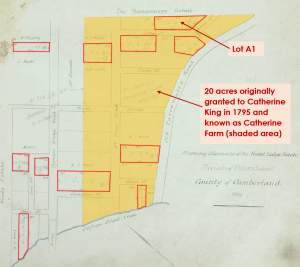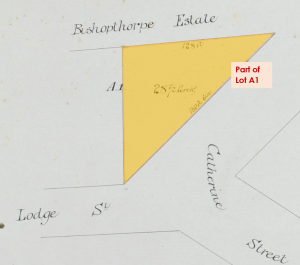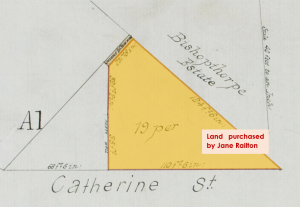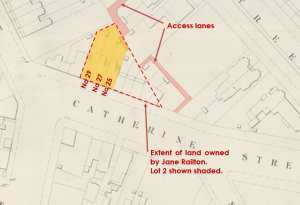Rodney Hammett, Bulletin 5/2022, July 2022
As a follow-up to the Bulletin story in March 2022 on Charles Perkins and the April 2022 confirmation by the State Government that a Blue Plaque will be fixed to the house he lived in, here is a story of the land and the house at 27 Catherine St, Forest Lodge.
At the time of the arrival of the First Fleet, the land in this vicinity was part of the territory of the Gadigal and Wangal clans of the Eora nation. When Governor Phillip granted land in the Glebe and Forest Lodge area, Catherine King, the wife of Robert King, was granted 20 acres in 1795, this becoming known as Catherine Farm (Figure 1). In 1834 Catherine Farm was purchased by chemist and druggist Ambrose Foss. The 31-acre Lot 26 of the 1828 Glebe subdivision, to the north of Catherine Farm, had previously been purchased by Foss, in 1833.1 & 2
Ambrose Foss lived for a time in Hereford House on Lot 26, the construction of which had been commissioned by George Williams in 1828. Further details of Ambrose Foss’ life and his influences on the early development of Glebe can be found in Max Solling’s Grandeur & Grit.3

Businessman and politician Thomas Ware Smart purchased 11 parcels of land in Forest Lodge in 1863, including Lot A1, which fronted Lodge St and Catherine Sts. All the lots outlined in red were purchased by Smart (Figure 1).
Born in Sydney in 1810, Thomas was the son of Thomas Smart, bootmaker, of Pitt St, who had arrived in the Admiral Gambier in 1808 with a seven-year sentence. After six years as an assistant in Cooper and Levey’s Waterloo warehouse Thomas junior joined Andrew Oliver for two years in a drapery business in Pitt St. In 1836, he set up as an auctioneer, estate, land and commission agent in George St. He soon acquired a large fortune and branched out into other activities, including banking and flour-milling. He died in 1881. Further details can be found in the Australian Dictionary of Biography.

Lot A1 comprised three roods six perches (3187 m2) and was, in July 1864, subdivided with builder Alfred Neate purchasing the 28½ perch (720 m2) triangular portion fronting Catherine St (Figure 2).
Alfred Neate (1821-1878) arrived in Sydney in 1854, leaving his wife Ann and six children at home in London. They joined him in about 1856. As a joiner and carpenter, he soon found work in the growing Sydney, later establishing himself as a builder living in Glebe and Forest Lodge with help from his sons Alfred George (1845-1922), John George (1847-1921) and Charles Edwin (1852-1921) as soon as they took up the tools.
Nos 25-31 Catherine St would have been built by Alfred senior with his sons during the time he owned the land (1864 to 1870). The Sands Directory of 1870 shows Alfred senior and family living in Old Parramatta Rd (now Arundel St) and Alfred junior with his new wife Eliza Jane Andrews living in one of the new houses in Catherine St.
The triangular property with houses was bought by butcher Daniel O’Connor of Botany Rd, Redfern, in September 1870, then by Michael McAuley, a gentleman of Sydney, in November 1872.
Cordial manufacturer William Simpson of Marrickville was the next owner from October 1879. Sydney timber merchants Frederick John Goodsell and James Wright purchased the property in May 1881.

In August 1884, the mortgagee took possession of the land and houses, which were then subdivided into two parts. Jane Railton of Petersham, a widow, purchased the larger part in November 1884, while the smaller part (Nos 31 and 33) was sold to financier Adolphus Rogalsky of Sydney in December 1887 (Figure 3).
Born in Brampton, Cumberland, England, in 1820, Jane Railton (née Routledge) grew up in the early 1800s sweat-shops of Huddersfield, Yorkshire, the daughter of parents trying to keep their family alive by working in the burgeoning cotton mills and clothing factories. Aged 18 in 1843, she married George Railton, a linen draper with his own business in Huddersfield. They had four children in England before travelling to Sydney. Another three children were born in Sydney.
George tried a number of jobs in Sydney. By 1871 he was a grocer at 2 Bay St, Glebe, and it was here that, on 28 December 1882, he died, aged 62. Jane moved to Oxford St, Petersham with what must have been a reasonable inheritance from George because soon afterwards, in 1884, she purchased the Catherine St property.4 She died in 1903, aged 78; the property was sold by the executors of her estate in 1904.

There were a number of owners between 1904 and 1926, at which time the property was subdivided into two lots – Nos 15 to 23 (Lot 1) and Nos 25, 27 and 29 (Lot 2) (Figure 4). Lot 2 lot was further subdivided in 1956 into three lots; one for each of the three houses. No 27 was purchased by Clarence McDonald Grey of Glebe, a labourer, in July 1961.
Charles Nelson Perkins, a student living in Glebe, purchased No 27 in June 1964 with his wife Eileen Laura Perkins. They sold the house in February 1967 to Noel Patrick Hogan, a member of the police force, and his wife Roslyn Eileen, both of Pagewood.
Notes: 1 NSW Land Registry Services; Primary Application 119 and Book G No 238; 2 Royal Australian Historical Society; Vo1/ 5 Part 5 (1929); Notes on the Early History of the Glebe by J F Campbell LS (Fellow); 3 Grandeur & Grit: A History of Glebe, Max Solling, pp 50, 52, 58; 4 At the same time Jane also purchased land in Trafalgar St, Annandale (near Piper St) and the land in Oxford St, Petersham. She purchased a property in Cook St, Randwick in 1891 where she and her children lived until she died.









There are no comments yet. Please leave yours.